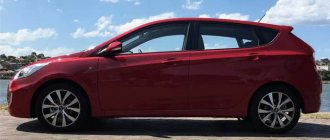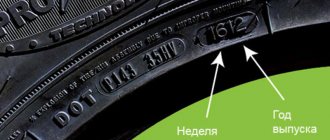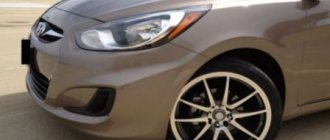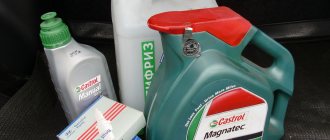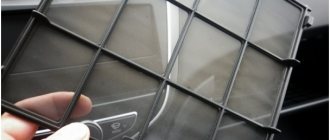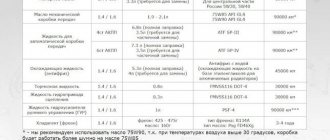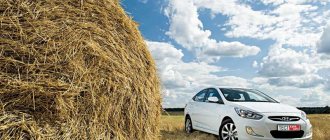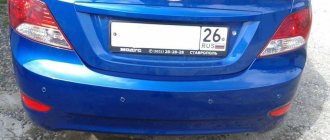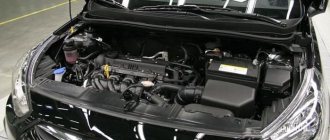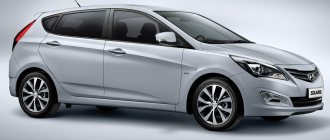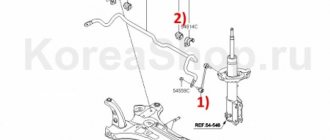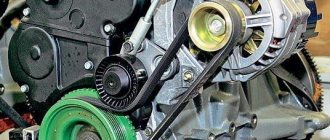Hyundai Solaris is a fairly popular car brand in our country. Owners of these cars periodically ask themselves the question: which tires are suitable for the Hyundai Solaris and whether it is possible to supply a non-standard size of wheels and tires.
This article will help answer this question and decide on the choice of tire and wheel sizes, as well as the most suitable brand of winter and summer tires for Hyundai Solaris.
The size of Hyundai Solaris factory tires depends on the year of manufacture of the car, as well as on the configuration. Thus, two tire sizes are installed at the factory:
- 185/65 R15
- 195/55 R16
Where the first numbers are the tire width in millimeters (185 mm and 195 mm, respectively). The second value is the percentage ratio of the tire profile height to its width. And the latter indicates the tire diameter in inches.
The factory equipment for cars in Russia is Hankook Optimo or Kumho Solus tires. By class, the tires belong to the budget category, but Hyundai car owners usually do not have any complaints about quality. Indicators such as wear, controllability and noise levels are within acceptable limits.
Depending on the configuration, Solaris is equipped with either cast alloy wheels or stamped metal wheels equipped with plastic decorative caps. Therefore, the parameters for tires and wheels will be slightly different.
Tire and wheel parameters for Hyundai Solaris with alloy wheels
- 195/55/R16
- Rim width (in inches) – 5.5j
- Bolt pattern (or drilling, PCD) - mounting hole, number of mounting holes per diameter of hole center circles (measured in millimeters) - 4x100
- Disc offset - the distance between the rim mounting plane and the wheel disc mounting plane (measured in millimeters) - ET52
- The diameter of the central hole for the hub is 54.1
Tire and wheel parameters for Hyundai Solaris with stamped wheels
- 185/65/R15
- Width – 5.5j
- Bolt pattern – 4x100
- Disc offset – ET48
- Diameter – 54.1
For visual comparison, the data is presented in table form:
| Disc type | Tire size | Rim width | Sverlovka | Disc offset | Hole diameter |
| Cast | 195/55/R16 | 5.5j | 4x100 | ET52 | 54.1 |
| Stamped | 185/65/R15 | 5.5j | 4x100 | ET48 | 54.1 |
What non-standard tire and wheel sizes can be supplied?
Many owners do simple tuning for their car to make its wheels more impressive or to change the characteristics of the car. To do this, they purchase wheels and tires with a larger diameter than the manufacturer recommends. However, you need to do this wisely, having thoroughly figured out which tires and wheels are suitable for the Hyundai Solaris.
If you reduce the profile height, the car will behave a little differently while driving: handling will improve, reactions to the steering wheel will become quick and clear. But at the same time, comfort suffers: such a car rides harder. This option is suitable for those drivers who prefer a sporty driving style.
As the profile height increases, the result is the opposite - comfort increases, the car drives softly and smoothly, road irregularities pass unnoticed. But the reactions to steering movements become noticeably more sluggish and seem to slow down. This option is suitable for lovers of a relaxed driving style who prefer comfort over fast driving.
However, changing the size of winter tires may have a lesser effect on the car's behavior on the road. When driving on ice, such changes most likely will not be felt at all.
Non-standard tire size for Hyundai Solaris, which should fit perfectly - tires with size 195/60 R15. 195/60 R16 is also suitable.
Available sizes are 195/65 R15 and 205/55 R16. However, with such parameters and the maximum load of the car, the tires can scratch on the fender liners. If driving smoothly and there are no large loads, it should not be noticeable.
In general, the choice of non-standard sizes should be approached intelligently. It is necessary to take into account all possible risks and inconveniences that such a replacement may lead to. This can lead to incorrect operation of the speedometer and odometer and the vehicle's electronic systems (such as ABS, EBD and others). This is due to the fact that the larger the outer diameter of the wheel, the higher the maximum speed of the car and the lower its acceleration dynamics, and vice versa. Also, changing tire size can affect the wear of some suspension and steering components.
A little about the car
Eight years is a sufficient period for car owners to comprehensively study and evaluate any car. And if the decision is made to release the next generation, it means that everything went as it should, sales are going well and all that remains is to take into account the opinions of the consumer, making the car even better. This is exactly what happened with the Hyundai Solaris.
Since this is a small class B city car, it was equipped with only two options for small engines - 1.4 and 1.6 liters. The first option, with a power of only 107 hp. was not in great demand, and therefore the number of its sales was significantly lower.
However, to work with a more powerful 1.6l engine, the automatic transmission was clearly not enough, which was the reason for some modifications to the model.
In particular, Hyundai has modernized the rear suspension several times, which has helped improve the car's stability when driving and eliminate sway on poor-quality road surfaces.
In the basic configuration, Solaris was equipped only with a 1.4 liter engine with a manual transmission, steel wheels (wheel diameter 14 inches) and only one airbag. No other security systems, including anti-lock ones, were installed on them.
Solaris 2011 (1st generation)
Three years later (in 2014), the car was restyled, and in the middle of the year the updated version was already on sale. The changes affected the gearbox, which added the number of steps, an electrical part, a steering wheel that became conveniently adjustable for reach, and new body painting options appeared.
Tire pressure
Tire pressure level is one of the most important indicators that determine the behavior of a car while driving on the road. Road traction and, in general, driving safety depend on tire pressure. Therefore, it is recommended to regularly measure tire pressure. The manufacturer recommends carrying out such a check simultaneously with refueling the vehicle. To do this, it is useful to keep a pressure gauge in the trunk. This way you can avoid rapid wear of the rubber.
Recommended tire pressure for Hyundai Solaris: 2.2 Bar (or 32 psi) for rear and front wheels. In other words, about 2.2 atmospheres. For full load, the manufacturer recommends maintaining the same pressure. This data is indicated on a plate located in the driver's doorway or in the operating manual.
Low tire pressure can lead to some unpleasant factors:
- Fuel consumption increases;
- Vehicle dynamics indicators decrease;
- Car handling deteriorates.
Tire pressure should only be measured when the tires are cold, otherwise the readings will be incorrect.
Which tires to choose for the summer
In the summer, the overwhelming majority of Hyundai Solaris drive on 185/65 R15 tires. Therefore, when choosing wheels on the eve of the summer season, we will take this size as a basis and, as always, turn to the results of tests conducted by some authoritative magazine or club specializing in such issues.
Summer Tire Marathon 2019
In our case, it will be the German auto club ADAC, which held the 2022 marathon for tires of the above size. Tires from 16 manufacturers took part in the test.
Its results turned out to be quite unexpected in the sense that some premium brands, which previously always occupied the first lines of the hit parade, moved down, giving way to tires from the medium sector.
Four rating categories were used: good, satisfactory, unsatisfactory and mediocre. Only two participants received the highest rating of “good”; all the rest received “satisfactory”. Fortunately, there were no lower ratings.
Let's look at the breakdown of participants based on the results of the auto review:
Bridgestone Turanza T005 (1st place)
The main surprise for the organizers of the auto review was Bridgestone, which took first place, since the summer tire of this brand rarely received prizes at such events.
But this time Turanza T005, which debuted the year before, 2022, broke all records, becoming the best on both dry and wet roads. And this is more than pleasant, considering that the previous model of this brand (Turanza T001) 3 years ago could only take 12th place.
Vredestein Sportrac 5 (2nd place)
The brainchild of the Russian-Dutch concern Vredestein, which today owns two Russian tire factories - Voronezh and Kirov, was able to approach the results of the Japanese Tyuranza.
True, the Sportrac 5 tire, which participated in testing, is produced in the Netherlands. It was only slightly inferior to the Bridge, and together with it was awarded a “good” rating, captivating the judges with its resistance to wear and excellent grip on wet roads.
Michelin CrossClimate+ (3 m)
Since all-season tires are still more summer than winter tires, they were also allowed to compete. These include the French-made Michelin CrossClimate+, which took an honorable third place in this race.
On wet asphalt, these tires showed a better level of grip than on dry pavement.
Goodyear EfficientGrip Performance (4 m)
EfficientGrip Performance tires from the American manufacturer Goodyear took a quite worthy fourth place.
They were among the best in terms of fuel efficiency and grip on dry surfaces, but on wet asphalt their behavior left much to be desired.
Firestone Roadhawk (5 m)
Another American tire under the Firestone brand, which has been owned by the Japanese Bridgestone for 30 years, showed almost the same results as its compatriot Goodyear. They had the same problem - not very good grip on wet surfaces.
Maxxis Mecotra 3 (6 m)
Not every Chinese product deserves blame, and the Mecotra-3 tire from Maxxis proved this by outperforming the vaunted Continental.
In principle, both it and the next Toyo received the same points as Firestone. The judges noted their efficiency in terms of fuel consumption.
Toyo Proxes CF2 (7 m)
The Japanese Toyo Proxes CF2 was also rated “satisfactory” and behaved much better on dry asphalt than on wet.
Kumho Ecowing ES01 KH27 (8 m)
The same can be said about Korean Kumho. Its problem is also poor grip on wet asphalt. But even on a dry road it was somewhat behind the same Toyo.
Continental PremiumContact 5 (9 m)
The fact that a premium quality tire ended up in ninth place, whereas in the previous test drive conducted in 2016, the same model was second, shocked everyone. This time it was unstable to wear, and generally did not prove itself a leader in any other disciplines.
Falken Ziex ZE310 Ecorun (10 m)
The Japanese tire Falken Ziex, together with the Semperit Comfort-Life2 that follows it (the brand also belongs to Continental), scored the same number of points in the fight as the PremiumContact 5. Therefore, all three models actually took ninth place.
Unlike the same Continental, they at least showed themselves decently on dry asphalt and in the wear test.
A fate as sad as that of the Continental befell the Korean Hankuk - the same model K-435 three years ago occupied 5th place, and now has slipped to 14th.
Of course, if the rally had been held not on a perfectly smooth European road, but on the realities of a domestic highway, the results most likely would have been completely different.
For a note: For example, the magazine “Behind the Wheel” conducted its own test to identify the best summer tire 2022, only in the 14th radius. So, in it, PremiumContact 5 was declared the winner, which in Germany could only take ninth place.
The conclusion suggests itself: in this world everything is relative, and in competitions, who your opponent is is of great importance.
You don’t have to be a great wheel specialist to look at the test table and see that in the Russian review the Continental “shone” against the backdrop of economy-class tires made in Indonesia, Russia and China. This is how some manufacturers increase their ratings among the people!
Pressure meter. How to disable it
Hyundai Solaris cars are equipped with a system for indirect measurement and monitoring of tire pressure. A sensor in the ABS system is responsible for this, which reads the wheel speed. The system monitors the difference in revolutions between wheels with a set rotation value.
When descending, the wheel reduces its radius and therefore rotates a little faster. It turns out that in one revolution a good tire travels a greater distance than a flat one. The sensor signals are compared in the ABS unit with control values. The system notices a discrepancy in values and reacts to this with an audible signal and an indicator on the dashboard.
There are no pressure sensors installed in the wheels themselves, so you can change them without fear. However, after replacing the wheels or as a result of service work, the indicator may light up, even if the tire pressure is fine. How can I disable this error? In this case, you must turn on the ignition and press the sensor initialization button for 3 seconds. This will complete the setup of the sensors and you will be able to continue driving with the new rims without any problems. The sensor now works with the new parameters.
Alternative drive options for Hyundai Solaris
- Cast: light weight, low pressure on support bearings, hub, transmission;
- Stamped: expensive, but durable;
- Forged: increased strength, lighter than all other models.
| Name | Manufacturer |
| Light alloy | IFREE OFF-LINE, HALFPIPE, LENINGRAD, RIDER NZ SH653 ALCASTA M32 TL 534, TL 526, TL 509, TL 540, TL 539, TL 634 VENTI 1603 |
| Stamped | TREBL 53B35B, 42B40B, X40014, X40032, X40033, X40054, 64A50C, 8873, 8756, X40026, 8114, 42B40B, 42E45S (15 radius) SDT U9014 J&L RACING J6604 1004 AR RIVO AR059 TZSK LADA LARGUS TEGER 9915ST ASTERRO TC1607C, TC1607F |
*check prices in stores at the time of purchase.
Wheel bolt pattern
The bolt pattern of the Hyundai Solaris is another important point when choosing wheels. This parameter is sometimes also called drilling. It consists of two numbers of the form X*X and is denoted by the abbreviation PCD in disc labeling. Shows the number of bolts on which the wheel is attached and the diameter of the circle on which they are located. On passenger cars, four to six studs are typically used.
For Solaris, the PCD value is 4*100, which means that the wheel is mounted on four bolts located on a circle with a diameter of 100 mm. The wheels of the Kia Rio, a classmate from another Korean manufacturer, have the same bolt pattern. The hub hole in the disk has a diameter of 54.1 mm, the thread on the studs is M12*1.50. This type of thread is widespread and is found on many cars. Its value should help when choosing flare nuts for securing wheels. The hub hole may be larger than specified.
Top 1. MICHELIN CrossClimate+
Rating (2021): 4.79
149 reviews from resources were taken into account: Mosavtoshina, Yandex.Market, MICHELIN
For the widest temperature range Two different rubber compound layers and tread design ensure that these tires can be used safely down to -5 degrees. But even in the summer heat you can safely rely on these tires.
- Characteristics
Average price: 11,000 rub.
- Country: France
- Load, kg: 560-630
- Speed, km/h: 190-240
- Tread pattern: symmetrical
The tire's tread rubber compound has a hard base layer that conducts heat away from the carcass and an elastic top layer that provides excellent traction over a wide range of temperatures. Some drivers fearlessly ride on these tires even in the first snow. By the way, the manufacturer positions them as summer ones, but also suitable for winter roads. The width of the sipes, which increase with wear, and their long gripping edges allow drivers to cope with snow-covered roads throughout their entire service life. Tires perfectly remove water from the contact patch. True, the car owner should be careful: water comes out from under the wheels in two fountains - you can accidentally stain pedestrians. Buyers note good handling and comfort during travel. But many people find them noisy and expensive.
Advantages and disadvantages
- Controllability
- Removes water well
- Wide temperature range
- Price
- Noisy
See also:
- 5 best batteries for Hyundai Solaris
to the beginning of the rating
Video: All the nuances when replacing a bearing
The section contains all the pitfalls that may arise when performing work.
How to remove the ball and steering joint without special pullers.
Your browser does not support the format
How to remove a stuck brake disc from the hub.
Your browser does not support the format
How to remove the hub from the bearing. There is an easier way, it is described in the section Replacing the front wheel bearing.
Your browser does not support the format
How to remove the old bearing race from the hub.
Your browser does not support the format
